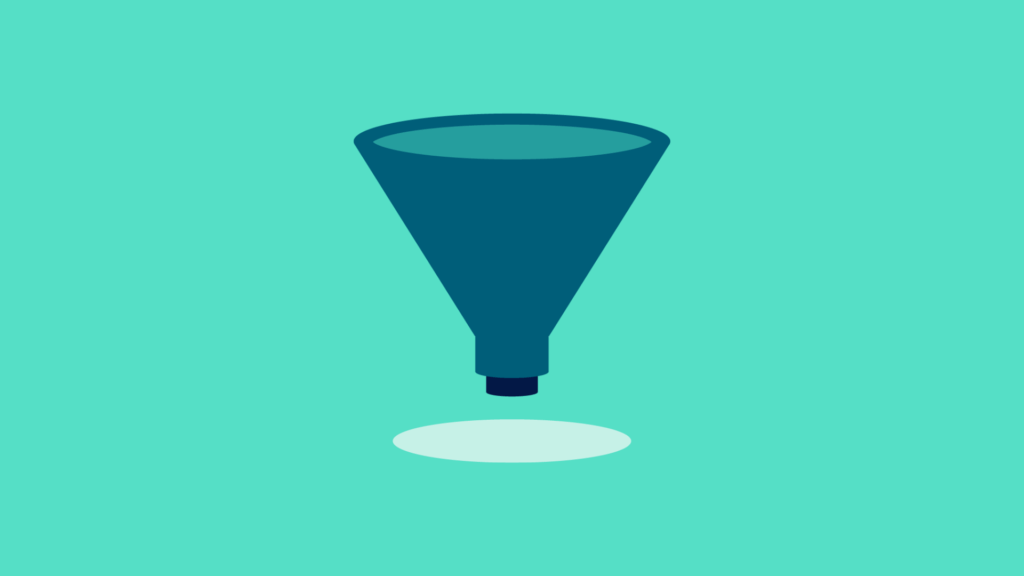Please raise a hand if you don’t want more customers. You didn’t raise your hand, did you? All SaaS marketers want more customers, and that’s why we spend countless days strategizing and trying to come up with something that’s going to make our dreams come true.
Marketing strategy formalizes the scope of actions you want to pursue. Ideally, it needs a foundation, something to build it upon. A marketing funnel could be the right foundation, so that your strategy outlines what, why, and how you are going to do at each stage of the funnel to convert more people into customers.
In this article, we’ll walk you through the essential stages and strategies of a B2B SaaS funnel and explain how you can build one tailored to your company.
The Four Stages of a B2B SaaS Marketing Funnel
A marketing funnel for a B2B SaaS company illustrates the journey a prospective customer takes to become a loyal customer of the brand.

“Building a marketing funnel is essential for a SaaS company because it aligns your messaging with potential customers’ journeys. You improve conversion rates and strengthen customer relationships by delivering the right information at the right time. It’s about strategically guiding prospects from awareness to becoming loyal, long-term users.”
It’s worth adding that in this article, we’ll use the terms “marketing funnel” and “sales funnel” interchangeably. A truly effective funnel requires alignment between marketing and sales teams.
The standard B2B SaaS marketing funnel includes four stages:
- Awareness (Top of the Funnel, or TOFU)
- Consideration (Middle of the Funnel, or MOFU)
- Decision (Bottom of the Funnel, or BOFU)
- Retention (still BOFU)
Keep in mind that in the B2B SaaS funnel, the conversion that occurs in the decision stage isn’t the ultimate goal. The primary objective in SaaS, especially in subscription-based models (which most SaaS companies operate with), is to retain existing customers for as long as possible and earn their loyalty.
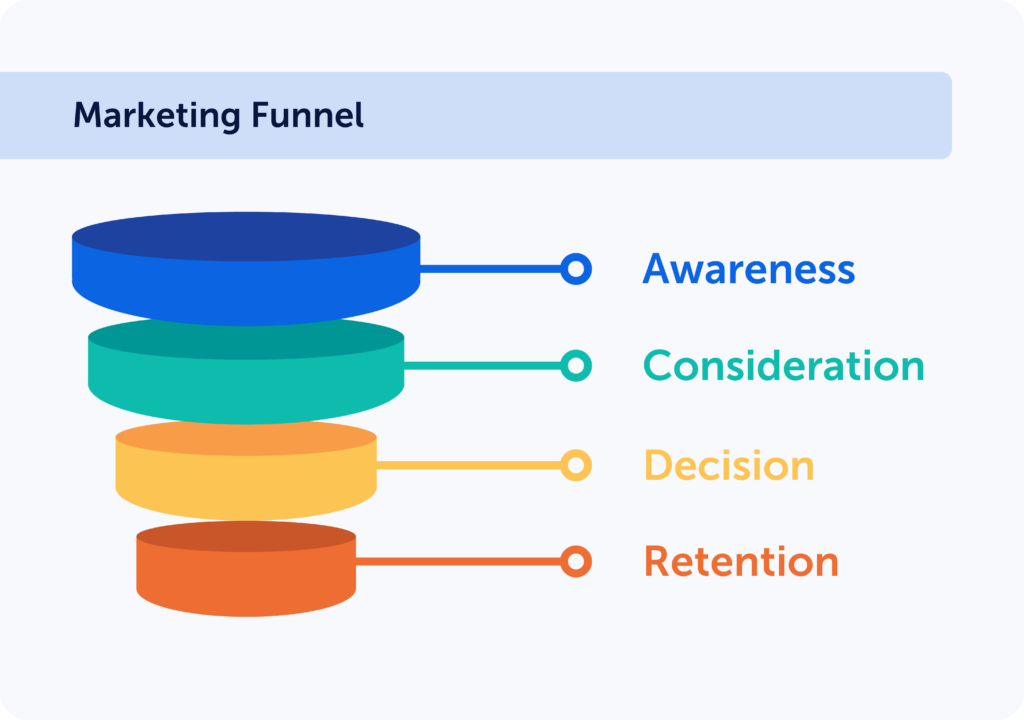
Disclaimer: The specific stages in a marketing funnel can vary and may be broken down into more detailed steps depending on your needs, but we’ll talk about that later. For now, let’s focus on a standard funnel that best aligns with the typical journey of a B2B SaaS buyer.
1. Awareness
The awareness stage, a.k.a. top of the funnel, is when users recognize they have a problem that needs a solution. At this point, they may not yet know what the solution looks like or where to find it, so they start researching.
Challenge: SaaS companies often target audiences who aren’t actively looking for a solution and are generally satisfied with their current options. In fact, 95% of your target audience isn’t in the market right now. Some will eventually notice problems on their own, but others might need your help to see what’s missing in their current setup.
This makes the awareness stage of marketing more challenging, as SaaS brands need to find ways to spark interest among prospects who haven’t yet recognized their own pain points. These prospects can be either new to the industry or competitors’ customers – which changes the tactics, but doesn’t change the general idea: you’re after them.
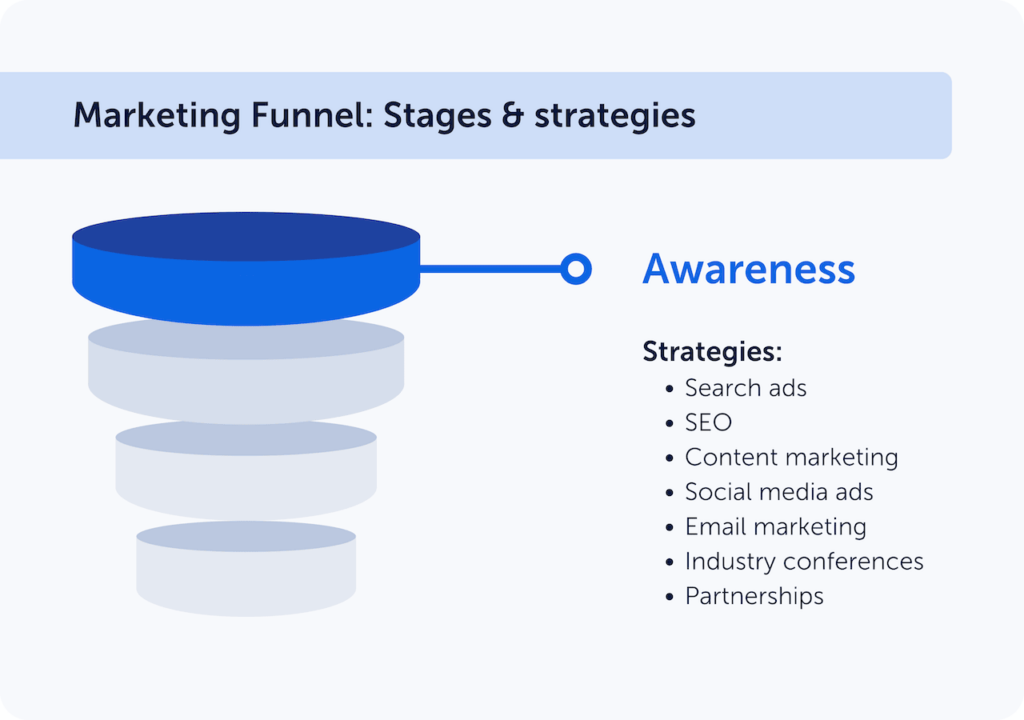
Strategies to Apply in the Awareness Stage
Regardless of the audience you’re targeting, you need effective top-of-funnel SaaS marketing strategies to drive them into your funnel.
To capture the attention of those in the research phase, search ads (most likely Google Ads) and content marketing are the most effective. At this stage, users are searching for informative content rather than specific brands.
This is where TOFU content comes in handy. This type of content educates readers on the subject, without overly focusing on your product, and aims to establish your brand’s expertise and build trust with the reader.

“In the awareness stage of the funnel, we focus heavily on SEO and content marketing to attract users. By creating high-quality, keyword-optimized content that addresses the pain points and questions of our target audience, we improve our visibility in search engines. This not only drives organic traffic but also positions us as a trusted resource, laying the groundwork for deeper engagement as users move through the funnel.”
For audiences not actively seeking solutions, you can generate brand awareness through social media advertising and direct sales outreach. Here, you can be more specific about your product and offer trials, but it’s still too early for a direct sales pitch. Those at the very top of the funnel aren’t leads yet, even if they left their contact information in exchange for some educational content piece.
Iris Dings, Sr. Content Manager at Unmuted, wrote a short horror story for our SaaStrophe series about sales demanding more leads for every content ineraction.
2. Consideration
In the consideration stage, your target audience explores potential solutions to their problem. They dive deeper into the topic and start evaluating your product alongside your competitors’ offerings.
For example, if a user in the awareness stage realizes they need to set up an e-commerce store to start selling online, they will enter the consideration stage as they begin researching various eCommerce platforms and website builders.
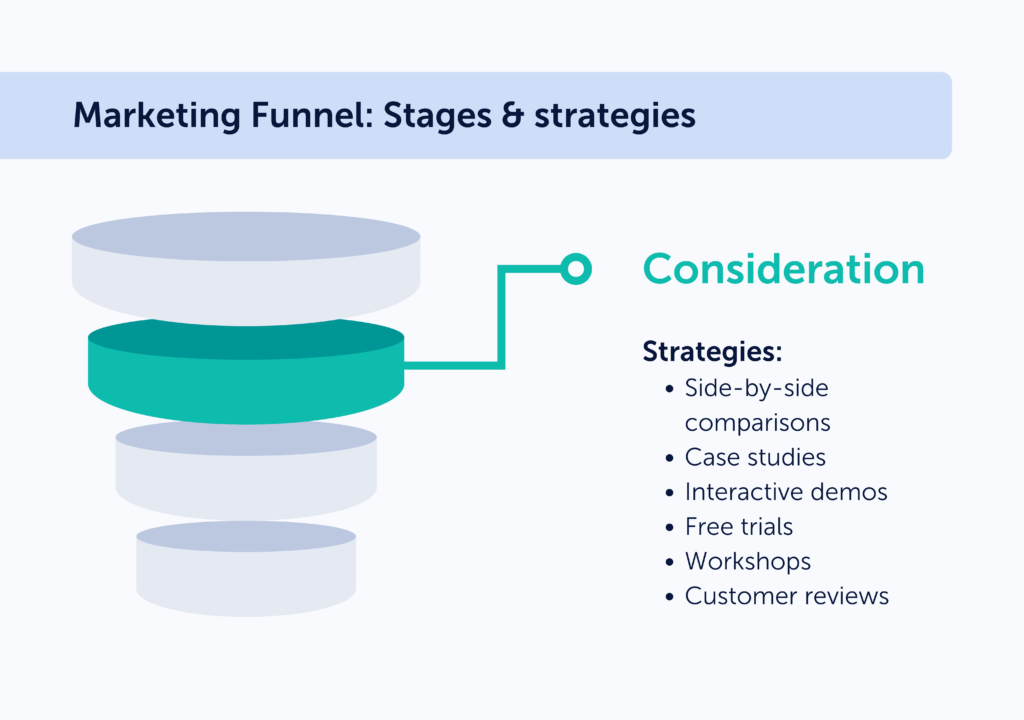
Strategies to Apply in the Consideration Stage
First, you need to present your product as one of the solutions to their problem. It’s still too early to push for a sale, so start by listing your product on relevant platforms or creating product listings of your own with the goal of ranking them in search engines and having AI tools pick them up.
Once prospects have all their options in front of them, they begin to weigh the pros and cons. This is when you need to showcase all the benefits of your solution. Use side-by-side comparisons, case studies, interactive or in-person product demos, free trials, and other resources to highlight the advantages of your product.
Tip: When you capture your audience’s attention in the awareness stage, you get an opportunity to move them down the sales funnel faster. Interlink your TOFU and MOFU campaigns so users naturally transition from one stage to the next. For instance, when a user lands on your TOFU content, design the website experience to encourage them to stay and explore more MOFU resources.
3. Decision
In this stage, buyers begin to lean toward a specific choice.
If they started a free trial in the consideration stage, they are now deciding whether to upgrade to a paid plan. Alternatively, if a sales rep has been guiding them through the funnel, this is the point where they accept the sales pitch and begin the implementation process.
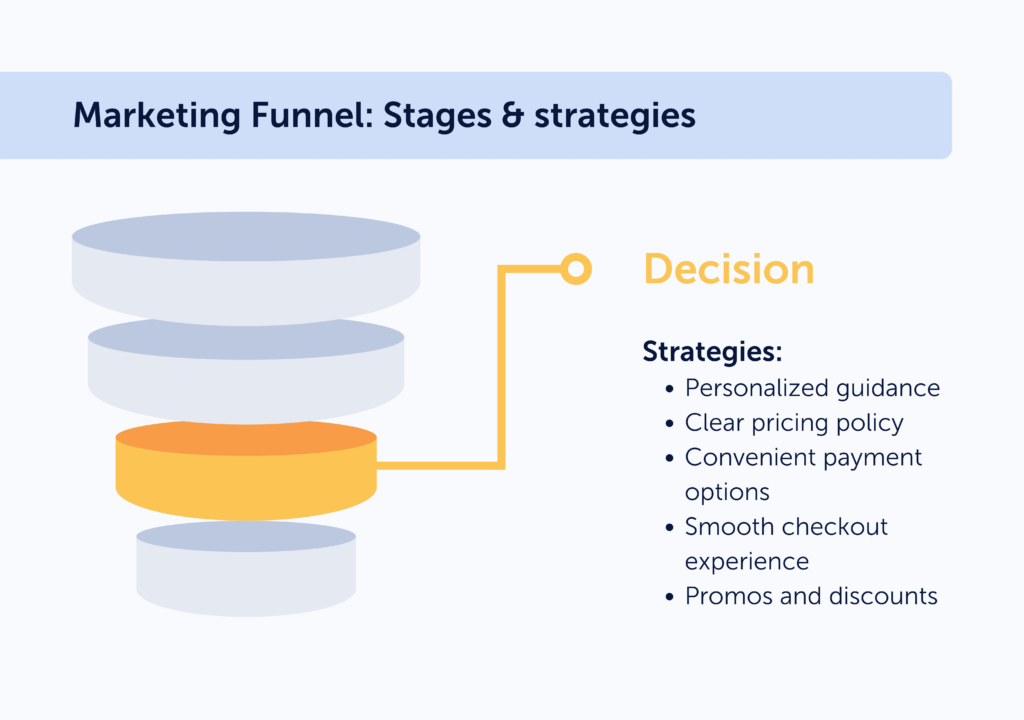
Strategies to Apply in the Decision Stage
While it may seem like you’ve done everything to drive prospects to conversion, in SaaS, this is only the beginning. To provide the best possible customer experience and prevent early churn, focus on the following:
- Create a smooth conversion experience. The purchasing process should be easy and straightforward.
- Offer a clear pricing policy. Make sure your pricing is transparent and easy to understand, with no hidden fees.
- Provide special offers. Introduce limited-time offers, discounts, or bundles to incentivize immediate purchase.
- Offer convenient payment options. Provide multiple payment methods to accommodate different customer preferences.
Tip: Maintain clear and open communication with prospects during this stage. Address any doubts or questions promptly to reinforce their decision to choose your product. In B2B SaaS, a lot of efforts at this stage will likely fall on the shoulders of your legal department as well. The more answers to potential concerns you can prepare in advance, the better.
4. Retention
Unlike a typical B2C conversion funnel, the B2B SaaS funnel extends beyond the conversion stage. The better you are at retaining existing users, the less reliant you become on acquiring new customers, which is from 5 to 25 times harder than building long-lasting customer relationships.
So yes, you absolutely have to properly map out the retention stage to achieve your profit goals.

Strategies to Apply in the Retention Stage
It takes cross-team collaboration to turn your new customers into loyal users. You’re going to work closely with the product team as well as customer support and success teams (assuming, of course, that your marketing team doesn’t perform all these functions, which happens in smaller startups).
Together with the product and customer success teams, you’ll have to map out a comprehensive onboarding process. Develop training sessions, in-app walkthroughs, and resources to facilitate smooth adoption.
Customer support must be ready to assist users through (ideally) multiple channels to quickly resolve issues and keep customers satisfied. Support teams should also conduct regular check-ins to gather feedback and pass it on to the product team to continue improving the product experience.
High customer satisfaction is what makes existing customers stick with your product, so measuring and improving it as much as possible is totally a must.
Community building has also become a popular and effective retention strategy. You may foster a sense of community among your customers through forums, social media groups, and events. Active community members become not only long-term users, but also advocates for your SaaS product, bringing in new customers through word-of-mouth.
How to Build a Marketing & Sales Funnel for Your SaaS
This was a snapshot of a standard marketing funnel. Your funnel stages and their timing will depend on your specific product and customer needs.
Think of the funnel we’ve described as a starting point. Tweak and customize it by following these steps:
Turn to Historical Data
Analyze your previous marketing and sales data to identify patterns and trends. Look at bottom-funnel metrics such as conversion rates, customer acquisition costs, and average deal size. Then backtrace your conversion paths all the way up.
Where do users that convert usually start their journeys? How are they moving from the initial touchpoint? How many touchpoints do they need at each stage? This data will help you reveal the actual funnel stages and double down on the most successful strategies for moving users down the funnel.
Tip: Use Mouseflow Journeys to track how visitors move to and from your key pages. Simply set your “Focus Step,” and Mouseflow will create journey maps showing user paths before and after they visit that page. You’ll also get insights into important data points like conversions between pages, drop-offs, and more.
Identify and Design the Customer Journey Touchpoints
Next, map out each stage of your funnel and define how you’ll interact with customers at every step. Begin with a funnel template and tailor it to fit your needs.
For example, if you need to create problem awareness proactively, your awareness stage might include many more touchpoints than a standard one.
Begin with your initial touchpoint—whether it’s LinkedIn ads, partner webinars, or industry conferences—and design a smooth path from there. For instance, if you’re co-hosting a webinar, you can follow up with an email sequence inviting them to sign up for a free trial of your product.
Remember, your customer journey won’t be linear.
Many prospects will stray from the intended path, and it’s fine. Not every attendee who doesn’t sign up immediately is lost; they may just need more time and information. Use multiple touchpoints and follow-up strategies to re-engage these prospects and guide them back toward conversion.
Set the Goals for Each Stage
Trying to push for a sale right from the awareness stage can overwhelm and deter potential customers. Similarly, not setting any goals means you’re just hoping for the best without a clear plan. So, what’s the solution?
Define SMART goals for each stage of your funnel—where SMART stands for specific, measurable, achievable, relevant, and time-bound.
What should happen when a person lands on your website for the first time? Perhaps you want to aim for specific engagement metrics, like the amount of time they spend on a page or how thoroughly they engage with your content.
You may also want to drive them down the path where they eventually share their contact information with you. Establish a target conversion rate (e.g., the percentage of visitors who become leads) and set a monthly goal for the number of leads you want to generate to maintain a healthy funnel.

“The most trivial metric for each funnel stage is the rate of users (potential customers) that proceed to the next stage. Besides traditional quantity metrics such as traffic volume, bounce rate, number of pages visited, etc., we also implement and pay attention to our own complex quality metrics, such as user engagement and visited content relevance.
These quality metrics help us understand which exact content resonates with visitors and how effectively it guides them through the funnel. By combining both quantity and quality metrics, we can make data-driven decisions to optimize our strategy.”
In the same way, you can set goals for each subsequent stage of the funnel. Now, you just need to set up tracking to monitor your progress.
Set up Tracking for Your Funnel
You can map out your sales and marketing funnels and monitor how users proceed through them right in Mouseflow.
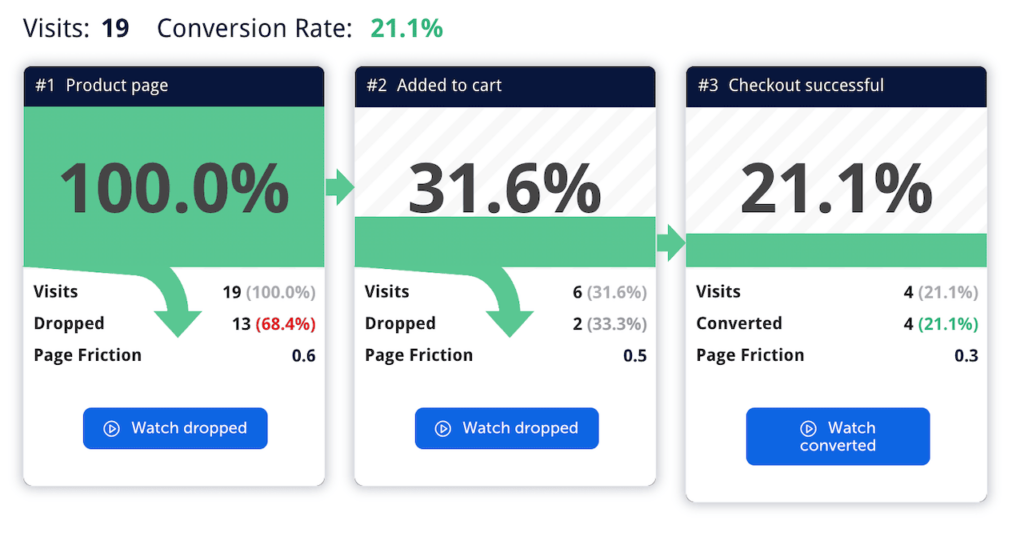
An example of a conversion funnel in Mouseflow
The setup process is very simple:
- Sign up for Mouseflow (we’ve got a 14-day free trial) and add Mouseflow to your website using Google Tag Manager.
- Move to Funnels and click “Add new Funnel.”
- Name your funnel and add the URLs that users navigate through before completing your target action.
- Click “Create Funnel” to start tracking. Mouseflow has been gathering statistics for all pages that you track since enabling it, so you may already have some data available. If not, wait for it to aggregate enough data – and get down to analyzing the funnel: the drop-offs, the conversion rates between stages, and the reasons behind them.
As you already know, users will take different paths to conversion. That’s why it’s best to create multiple funnels to cover different scenarios. Use historical data from Mouseflow Journeys to get ideas for additional funnels.
When you’re all set, you’ll have a bird’s-eye view of your audience’s journeys from the moment they land on your website. You’ll be able to see where users drop off and why (since Mouseflow records all user sessions for you) and take informed actions to improve your user experience (UX).
Build a Marketing Funnel That Converts
A marketing and sales funnel isn’t something you set and forget. As your understanding of your customer journey evolves, you’ll need to revisit and refine your funnels to align better with your customers’ actual paths to purchase. This is why UX monitoring is essential for funnel development.
Sign up for Mouseflow to build funnels that drive desired results.
